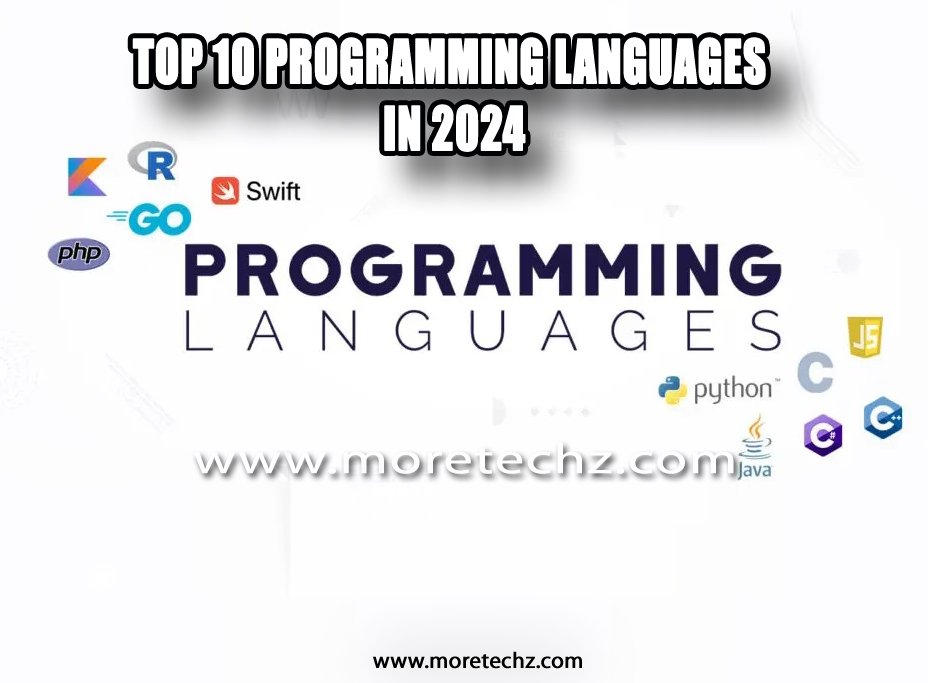Top 10 Programming Languages in 2024
In the consistently developing scene of innovation, programming dialects assume a vital part in forming how we cooperate with programming and fabricate creative arrangements. As we step into 2024, it’s pivotal to keep up to date with the programming dialects that are standing out regarding fame, flexibility, and reception. In this exhaustive aid, we’ll dig into the main 10 programming dialects that are causing disturbances in 2024, investigating their elements, use cases, and explanations for their conspicuousness.
1. Python
Beating out everyone else by and by is Python, prestigious for its straightforwardness, comprehensibility, and broad libraries. Python’s flexibility makes it number one among designers for many applications, including web improvement, information investigation, man-made brainpower, and AI. Its instinctive linguistic structure and powerful biological system have pushed it to the very front of programming dialects, solidifying its situation as a go-to decision for the two novices and preparing engineers the same.
2. JavaScript
As the foundation of current web improvement, JavaScript keeps on overwhelming the programming scene in 2024. With the ascent of structures like Respond, Precise, and Vue.js, JavaScript has become crucial for building dynamic and intelligent web applications. Its client-side prearranging capacities empower engineers to make rich client encounters, while server-side structures like Node.js stretch out its usefulness to backend improvement, making JavaScript a force to be reckoned with in the product improvement domain.
3. TypeScript
Expanding upon JavaScript’s establishment, TypeScript has arisen as a conspicuous decision for huge-scope venture applications. Offering static composing, improved tooling, and better code association, TypeScript gives designers the certainty to handle complex undertakings while keeping up with code honesty and versatility. Its consistent combination with well-known systems and libraries has added to its developing prevalence, especially in enterprises where power and unwavering quality are vital.
4. Rust
Known for its accentuation on execution, security, and simultaneousness, Rust has accumulated consideration for its capacity to convey elite execution frameworks with insignificant gamble of memory mistakes and information races. With its severe compiler checks and ergonomic language structure, Rust engages designers to compose proficient and solid code, pursuing it as an ideal decision for framework programming, game turn of events, and execution of basic applications. Its developing biological system and local area support signal a promising future for Rust in 2024 and then some.
5. Go (Golang)
Supported by Google, Go has built up momentum as a flexible programming language reasonable for building versatile and simultaneous applications. With its straightforwardness, quick arrangement times, and underlying help for simultaneousness, Go succeeds in backend advancement, microservices design, and cloud-local applications. Its vigorous standard library and proficient runtime make it appropriate for sending applications under conditions, driving its reception among new companies and tech goliaths the same.
6. Kotlin
As the favored language for Android application advancement, Kotlin has encountered fast development since its true underwriting by Google in 2017. Offering present-day highlights, consistent interoperability with Java, and improved security ensures, that Kotlin has turned into the language of decision for building Android applications. Its succinct language structure and expressive highlights support engineer efficiency, while its similarity with existing Java codebases works with a smooth change for designers hoping to take on Kotlin in their undertakings.
7. Swift
For iOS and macOS advancement, Quick remaining parts the language of decision among engineers looking for speed, security, and innovation. Ceaselessly advancing with new highlights and enhancements, Quick empowers designers to fabricate vigorous, performant applications that influence the full abilities of Apple’s environment. Its instinctive grammar, high-level memory for the executives, and strong elements like optionals and generics make it appropriate for creating state-of-the-art versatile and work area applications.
8. R
Broadly utilized in measurable figuring and information examination, R keeps on being a staple in the information science local area. With its rich biological system of bundles and libraries for measurable demonstrating, perception, and AI, R engages scientists and experts to get experiences from complex datasets. Its intelligent climate and consistent coordination with instruments like Jupyter journals make it a basic device for exploratory information investigation, prescient displaying, and logical examination.
9. Julia
Intended for elite execution of mathematical registering, Julia joins the usability of dynamic dialects with the speed of customarily arranged dialects. It’s in-the-nick-of-time (JIT) arrangement and different dispatch highlights empower engineers to compose code that equals the exhibition of low-level dialects like C and Fortran, making it ideal for logical processing, computational material science, and mathematical recreations. Julia’s developing local area and biological system of bundles signal its capability to upset the field of specialized processing in the years to come.
10. Dart
As the programming language behind Ripple, Dart has arisen as a considerable competitor in the realm of cross-stage application improvement. Offering a receptive system, hot reload usefulness and local execution, Vacillate empowers designers to construct delightful and responsive applications for versatile, web, and work area stages from a solitary codebase. Dart’s effortlessness and engineer cordial elements make it an alluring decision for building natural UIs and vivid encounters across different gadgets.
All in all, the programming dialects illustrated above address the best of the best in 2024, each offering special qualities and abilities to address the different necessities of designers and organizations the same. Whether you’re building web applications, portable applications, information-driven arrangements, or elite execution frameworks, these dialects give the devices and assets important to rejuvenate your thoughts in the always-growing universe of innovation. As we look forward, it’s crucial to stay informed and adjust to the advancing scene of programming dialects to stay serious and creative in an undeniably computerized world.
